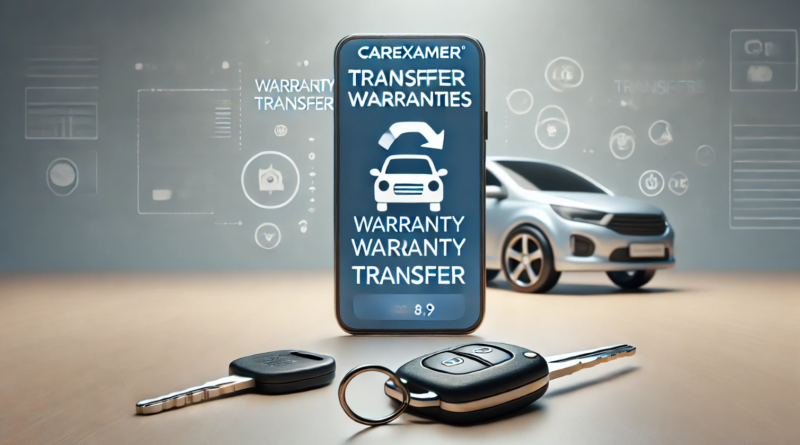How to Transfer Warranties When Buying a Used Car
Let’s break it down how to transfer warranties when buying a used car. Buying a used car can save you a lot of money, and if the car still has a valid warranty, it’s like icing on the cake. But here’s the thing—warranties don’t just magically transfer over to the new owner. You need to follow a few steps to make sure you’re covered. Don’t worry, though—it’s not as complicated as it sounds.
What’s a Transferable Warranty, and Why Should You Care?
A transferable warranty is just what it sounds like—a warranty that can be passed from the original owner to you when you buy their car. Whether it’s a manufacturer warranty or an extended one, it means you’re covered for certain repairs or replacements without footing the entire bill.
Why does it matter?
- You save money: Major repairs can cost a fortune, but a warranty can take care of them for you.
- It boosts resale value: If you ever decide to sell the car, having a warranty makes it more attractive to buyers.
- You get peace of mind: Driving a car with warranty coverage feels way better than worrying about unexpected breakdowns.
Steps to Transfer a Warranty
Here’s a simple, step-by-step guide to getting that warranty in your name.
1. Check the Warranty Terms
First things first—make sure the warranty can actually be transferred. Some warranties are designed to stay with the original owner and can’t be passed on.
Where to start:
- Read the warranty paperwork (or ask the seller for it).
- Check online or contact the warranty provider if you’re unsure.
What to look for:
- Is it transferable? Not all warranties are.
- Any fees involved? Some providers charge a small fee for the transfer.
- Any deadlines? You might need to transfer it within a certain timeframe after buying the car.
2. Gather the Documents You’ll Need
Once you know the warranty is transferable, you’ll need a few documents to prove you’re the new owner.
Here’s what to collect:
- The warranty paperwork: This shows the warranty’s terms and conditions.
- Proof of purchase: A bill of sale or receipt to confirm you bought the car.
- Service records: If the warranty requires regular maintenance, having these records helps confirm the car was properly cared for.
The more organized you are, the smoother this process will go.
3. Notify the Warranty Provider
Now it’s time to let the warranty provider know that you’re the new owner. This is where the transfer officially happens.
How to do it:
- Visit the warranty provider’s website—they might have an online transfer form.
- Call their customer service number if you’re not sure how to proceed.
What you’ll need to share:
- Your proof of purchase.
- The warranty paperwork.
- Payment for any transfer fees, if required.
Once everything is submitted, the provider will update their records, and the warranty will be all yours.
4. Double-Check the Fine Print
Before you celebrate, take a moment to review the warranty’s terms and conditions.
What to watch for:
- Coverage period: Make sure you know when the warranty starts and ends.
- What’s covered (and what’s not): Some warranties exclude certain parts or repairs.
- Transfer fees or restrictions: Ensure all requirements have been met so the transfer is valid.
By understanding the details, you’ll avoid surprises if something goes wrong with the car.
Extra Tips for a Hassle-Free Transfer
- Act quickly: Some warranties require the transfer to be completed within a certain number of days after the car is sold. Don’t procrastinate!
- Keep copies of everything: Hold onto copies of all documents and communications with the warranty provider.
- Consider buying extended coverage: If the warranty doesn’t cover everything you need, you can look into purchasing additional coverage for extra peace of mind.
Common Types of Transferable Warranties
- Manufacturer warranties: These are the ones provided by the car’s maker, like a powertrain warranty or bumper-to-bumper coverage. They’re often transferable within the coverage period.
- Certified Pre-Owned (CPO) warranties: Cars sold as certified pre-owned usually come with warranties that automatically transfer to new owners.
- Extended warranties: If the seller purchased an additional warranty, check if it can be transferred to you. Some third-party providers allow it, but there may be stricter rules.
Why Transferring a Warranty Is Worth It
Transferring a warranty may take a little paperwork, but it’s well worth the effort. It gives you the confidence to enjoy your “new-to-you” car without worrying about unexpected repair bills. Plus, if you ever decide to sell the car, having that warranty in place makes it a more attractive option for buyers.
So, whether you’re buying a used car from a dealership or a private seller, don’t forget to ask about the warranty. With just a little time and effort, you can make sure the coverage is yours—and that peace of mind is priceless.
Buying a used VW. Buying used vauxhall, BMW, Jaguar, Ford, Volvo, Range rover, Bentley, Aston Martin, Porsche, Ferrari, Lamborghini, Maserati, Hyundai, Tesla, Honda, Pagani

